Epic Preparations
Good morning, EDHREC! I’m Bernardo Melibeu and this is The Epic Experiment, a series where we throw all common sense aside and experiment with some unusual cards, effectively changing how we normally build our deck. Is it going to work? Who knows?! We’re making science here. When you’re an Izzet mage, blowing things up in front of your own face is half the fun.
In this article we'll be worshiping a false god (if that's not a flavor win, I don't know what is), Karona, False GodKarona, False God.
Let's get into the action
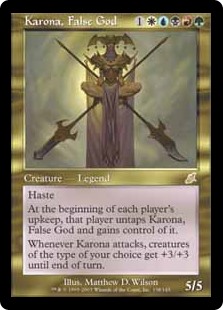
Haste
At the beginning of each player's upkeep, that player untaps Karona and gains control of it
Whenever Karona attacks, creatures of the type of your choice gain +3/+3 until end of turn
Observation 1:
She loves go-wide tribal strategies and can be used as a late-game trump card in those kinds of decks.
Observation 2:
Even if we don't consider the obvious tribal synergy, an 8/8 haste commander for six mana is quite a deal.
Observation 3:
She has synergies with extra combat step spells.
Observation 4:
Her drawback can be huge, but fortunately we can use cards to circumvent that, or we can try to play around the tribal player.
The Old Formula
With that in mind, let’s head to Karona’s EDHREC page and see how she’s usually built:
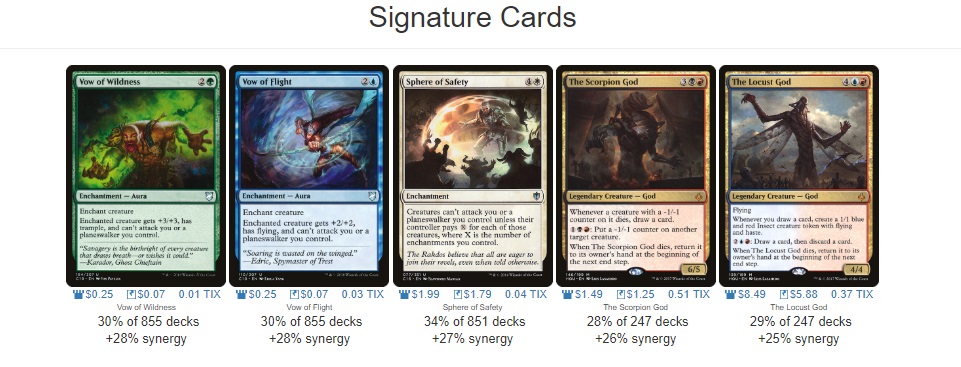
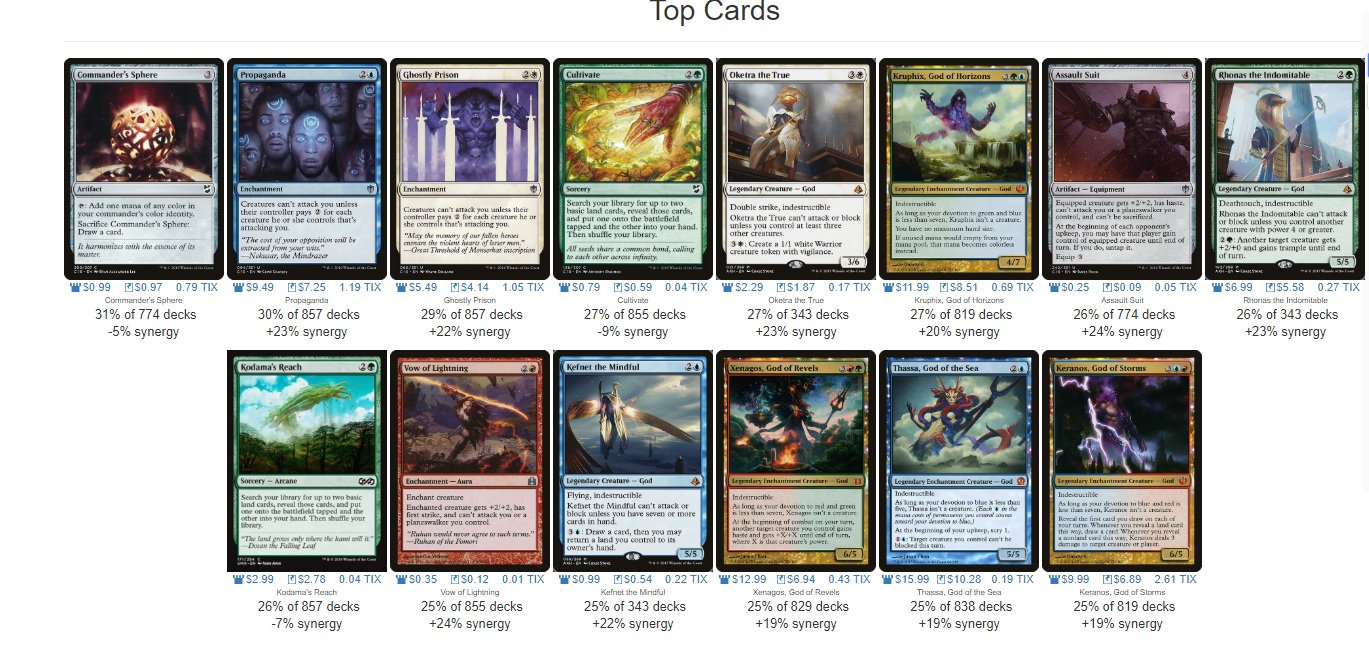
We can see that the Vow cycle is strongly represented among Karona's lists. One thing that can be confusing, at first, is the inclusion of "random" cards like The Scorpion GodThe Scorpion God and The Locust GodThe Locust God, which seems too go in different types of decks, but after considering that 'God tribal' is a popular theme, that starts to make sense. The few slots left are dedicated to ramp and PropagandaPropaganda effects.
The Epic Ingredients
We probably already established that we're going to build a tribal deck, but which tribe? We need a mostly four- or five-color tribe, that tends to go wide and is aggressive/fast enough to have Karona's effect be lethal (or almost lethal). While reviewing my personal list for this year's top 10 cards, I stumbled to a very powerful tribal lord I hadn't yet seen, Najeela, the Blade-BlossomNajeela, the Blade-Blossom. She's the lord that I didn't know I wanted. This synergy between Najeela and Karona was the main deciding factor to choose Warriors for this deck.
First, let's delve into the tribe. Warriors are a typically spread among four colors (generally they're not blue). Not only are they in a lot of colors, but they also aren't restricted to specific planes, and have been featured strongly in both a full block and a supplementary set (Khans of Tarkir and Battlebond). This means that we have a higher card density than, let's say, Gods. We can clearly see this after looking at the creature suite.
In fact, I'm going to make a bold claim: this might be one of the most effective/efficient batch of creatures I've seen in a long time (and I've built a Sliver deck)! We basically have three categories of Warriors. The first are the utility-based lords, which grant a wide variety of bonus that can help us get through damage. Second are the damage-based lords, cards that will make our creatures bigger. Oh, and the last category? Beaters, plain and simple.
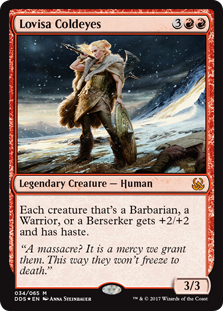
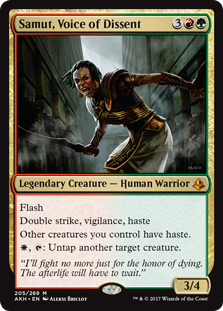
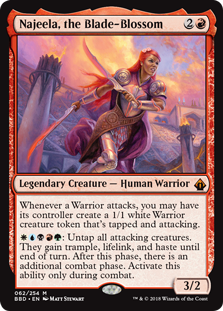
For the first category we have haste enablers like Madrush CyclopsMadrush Cyclops, Ogre BattledrivesOgre Battledrives, Rushblade CommanderRushblade Commander, and Samut, Voice of DissentSamut, Voice of Dissent. These allow us to have explosive early turns, while also allowing us to recover from board wipes more effectively on the mid/late parts of the game. Since we're playing with medium-sized creatures, having multiple ways to get through blockers is very important. We have the menace-granting Blood-Chin RagerBlood-Chin Rager to the trample enablers like Bramblewood ParagonBramblewood Paragon, Khenra CharioteerKhenra Charioteer and Surrak DragonclawSurrak Dragonclaw, and even the near-unblockability of Champion of LambholtChampion of Lambholt and Nacatl War-PrideNacatl War-Pride (though in the case of that last one, we would have to focus the attack on a single player).
While it's true that our commander is an anthem effect (meaning that we could theoretically just try to go wide with our creatures before playing her), having a few other lords can help deal some early damage while also being relevant in the later stages of the game. Plus, unlike the evasion/haste effects, power-boosting lords get better in multiples. Chief of the EdgeChief of the Edge, Honored Crop-CaptainHonored Crop-Captain, and Lovisa ColdeyesLovisa Coldeyes all basically do the same thing: pump the team. Arashin ForemostArashin Foremost is a nice beater that have the upside of also giving double strike on entering and when attacking (if we have a haste enabler, she could give the bonus to two different creatures in one turn). Metallic MimicMetallic Mimic is a cheap bonus to all of the following Warriors that we play, and also has the upside of being only colorless Warrior (we'll talk about that later).
We also need to talk about card draw. Being an aggressive deck is difficult because while we need to commit to the board, we can't fall behind on cards, otherwise one board wipe and we're screwed. The best case scenario are creatures that draw us cards, like Azra BladeseekerAzra Bladeseeker, Azra OddsmakerAzra Oddsmaker and Mindblade RenderMindblade Render, but since there are so few of those with the Warrior type, we need to carefully consider our options. Luckily, we're in all five colors. Raiders' SpoilsRaiders' Spoils is a nasty Magic card, paying 1 life to draw a card is an borderline overpowered ratio, and it also pumps our team! Rishkar's ExpertiseRishkar's Expertise won't be drawing us as much as it normally would (usually will be 3 or 4 cards), but after considering that it has the potential to play up to a five-drop spell, it's understandable to take a slot in this deck. Vanquisher's BannerVanquisher's Banner (which you can read more about here ) and Kindred DiscoveryKindred Discovery grant us cards when we play our Warriors, allowing us to chain multiples more easily.
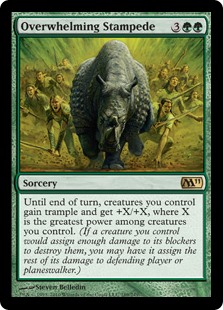
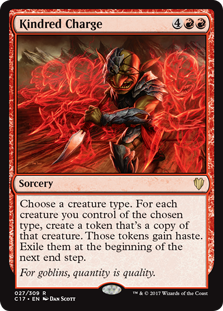
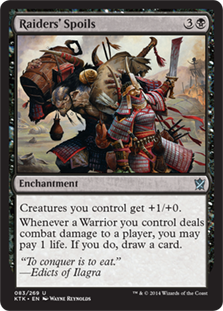
For finishers we have two OverrunOverrun effects in the form of Overwhelming StampedeOverwhelming Stampede and Triumph of the HordesTriumph of the Hordes. We also have two creature "doubler" spells, Kindred SummonsKindred Summons and Kindred ChargeKindred Charge. It's worth noting that the first effect will only help us if we already have a decent size board to benefit from it, while the second type can help us get to that point.
Let’s check out how it all comes together!
The Mixture
Karona Warriors
View on ArchidektCreature (40)
- 1 * Ahn-Crop Crasher* Ahn-Crop Crasher
- 1 * Arashin Foremost* Arashin Foremost
- 1 * Azra Bladeseeker* Azra Bladeseeker
- 1 * Azra Oddsmaker* Azra Oddsmaker
- 1 * Banewhip Punisher* Banewhip Punisher
- 1 * Battle Brawler* Battle Brawler
- 1 * Blood-Chin Rager* Blood-Chin Rager
- 1 * Bramblewood Paragon* Bramblewood Paragon
- 1 * Brutal Hordechief* Brutal Hordechief
- 1 * Champion of Lambholt* Champion of Lambholt
- 1 * Chief of the Edge* Chief of the Edge
- 1 * Combat Celebrant* Combat Celebrant
- 1 * Decorated Champion* Decorated Champion
- 1 * Den Protector* Den Protector
- 1 * Duskwatch Recruiter* Duskwatch Recruiter
- 1 * Earthshaker Khenra* Earthshaker Khenra
- 1 * Goblin Cratermaker* Goblin Cratermaker
- 1 * Grand Warlord Radha* Grand Warlord Radha
- 1 * Honored Crop-Captain* Honored Crop-Captain
- 1 * Iroas, God of Victory* Iroas, God of Victory
- 1 * Khenra Charioteer* Khenra Charioteer
- 1 * Lovisa Coldeyes* Lovisa Coldeyes
- 1 * Madrush Cyclops* Madrush Cyclops
- 1 * Manic Vandal* Manic Vandal
- 1 * Mardu Strike leader* Mardu Strike leader
- 1 * Mardu Woe-Reaper* Mardu Woe-Reaper
- 1 * Matca Rioters* Matca Rioters
- 1 * Metallic Mimic* Metallic Mimic
- 1 * Mindblade Render* Mindblade Render
- 1 * Mirri, Weatherlight Duelist* Mirri, Weatherlight Duelist
- 1 * Nacatl War-Pride* Nacatl War-Pride
- 1 * Najeela, The Blade-Blossom* Najeela, The Blade-Blossom
- 1 * Ogre Battledriver* Ogre Battledriver
- 1 * Rubblebelt Raiders* Rubblebelt Raiders
- 1 * Ruric Thar, the Unbowed* Ruric Thar, the Unbowed
- 1 * Rushblade Commander* Rushblade Commander
- 1 * Samut, Voice of Dissent* Samut, Voice of Dissent
- 1 * Surrak Dragonclaw* Surrak Dragonclaw
- 1 * Thrasher Brute* Thrasher Brute
- 1 * Warden of the First Tree* Warden of the First Tree
Artifact (8)
- 1 * Akroma's Memorial* Akroma's Memorial
- 1 * Chromatic Lantern* Chromatic Lantern
- 1 * Fellwar stone* Fellwar stone
- 1 * Sol Ring* Sol Ring
- 1 * Talisman of Impulse* Talisman of Impulse
- 1 * Talisman of Indulgence* Talisman of Indulgence
- 1 * Talisman of Unity* Talisman of Unity
- 1 * Vanquisher's Banner* Vanquisher's Banner
Sorcery (8)
- 1 * Farseek* Farseek
- 1 * Kindred Charge* Kindred Charge
- 1 * Nature's Lore* Nature's Lore
- 1 * Overwhelming Stampede* Overwhelming Stampede
- 1 * Patriarch's Bidding* Patriarch's Bidding
- 1 * Rishkar's Expertise* Rishkar's Expertise
- 1 * Skyshroud Claim* Skyshroud Claim
- 1 * Triumph of the Hordes* Triumph of the Hordes
Instant (4)
- 1 * Anguished Unmaking* Anguished Unmaking
- 1 * Cyclonic Rift* Cyclonic Rift
- 1 * Kindred Summons* Kindred Summons
- 1 * Swords to Plowshare* Swords to Plowshare
Enchantment (3)
- 1 * Kindred Discovery* Kindred Discovery
- 1 * Phyrexian Reclamation* Phyrexian Reclamation
- 1 * Raiders' Spoil* Raiders' Spoil
Land (36)
- 1 * Blood Crypt* Blood Crypt
- 1 * Bloodstained Mire* Bloodstained Mire
- 1 * Bountiful Promenade* Bountiful Promenade
- 1 * Breeding Pool* Breeding Pool
- 1 * Brushland* Brushland
- 1 * Canopy Vista* Canopy Vista
- 1 * Cinder Glade* Cinder Glade
- 1 * City of Brass* City of Brass
- 1 * Command Tower* Command Tower
- 1 * Exotic Orchard* Exotic Orchard
- 1 * Flooded Strand* Flooded Strand
- 2 ForestForest
- 1 * Godless Shrine* Godless Shrine
- 1 * Hallowed Fountain* Hallowed Fountain
- 1 * Island* Island
- 1 * Karplusan Forest* Karplusan Forest
- 1 * Llanowar Wastes* Llanowar Wastes
- 1 * Luxury Suite* Luxury Suite
- 1 * Mana Confluence* Mana Confluence
- 1 * Morphic Pool* Morphic Pool
- 1 * Mountain* Mountain
- 1 * Overgrown Tomb* Overgrown Tomb
- 1 * Plains* Plains
- 1 * Polluted Delta* Polluted Delta
- 1 * Reflecting Pool* Reflecting Pool
- 1 * Sacred Foundry* Sacred Foundry
- 1 * Spire Garden* Spire Garden
- 1 * Steam Vents* Steam Vents
- 1 * Stomping Ground* Stomping Ground
- 1 * Swamp* Swamp
- 1 * Temple Garden* Temple Garden
- 1 * Watery Grave* Watery Grave
- 1 * Windswept Heath* Windswept Heath
- 1 * Wooded Foothills* Wooded Foothills
- 1 * Yavimaya Coast* Yavimaya Coast
The first problem that we need to overcome while building this list is its mana. Being five-color and aggressive means that we need access to multiple colors very early, but without the luxury of taking time in the early portion of the game to ramp and fix our mana in the methodical way a deck like Ramos, Dragon EngineRamos, Dragon Engine would. There'll be hands that we won't keep because of awkward color combination. Fetching lands (both with the lands and with ramp spells) will be something that we must pay attention to; we can't afford losing a turn because we didn't get the right land on an earlier turn.
The ramp suite was designed to mitigate this. Outside of the obvious Sol RingSol Ring and the five-color staple Chromatic LanternChromatic Lantern, we're basically just playing two-mana ramp spells that can either get a dual land out of our deck or can generate two colors on its own. CultivateCultivate and Kodama's ReachKodama's Reach were considered, but, after some testing, the three-mana cost and the fact that we are playing with very few basics meant they weren't worth it.
Methodology
For our opening hand, we need two things: a game plan and the mana to execute it. The first part implies that we have some early creatures that will allow us to start the game aggressively. The last part is a variation from the first; after all, having good creatures is useless if don't have the mana to cast them.
In the early game, we need to start building a board and look for free attacks on slower opponents. It's very easy to deal 6-7 damage on turn four, and our opponents won't be able to ignore it for very long. There's something important for the sequence in which we play our creatures, too. For example, putting our haste enablers into play when we can curve out on the next turn. Prioritize playing mana rocks when we have something else to play and ramp spells when we don't, since mana rocks are more mana efficient than the ramp spells.
By turn five or six, if we curve out well, we'll have about 10-12 power on the table. This is where our evasion creatures will come in handy, since most opponents will have creatures that could trade with our own (normally it isn't a good idea to trade card-for-card without a back up plan). We don't need to worry about casting our commander as long as we have cards to play, since the threat of Karona will make our opponents play very carefully. Board wipes may set us back, but again, we can always play Karona and hit someone for 8. Finding some card draw engine will also be a factor in whether or not we recover well from it. As turns pass, being able to correctly target the biggest threat will become more and more crucial, and mistakes will snowball very quickly.
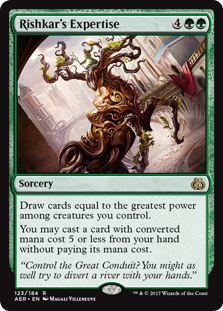
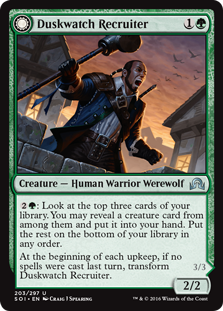

Late game is tricky to predict. If we did our job right, by now we won't have to deal with three other players, but the amount of board wipes and single target removal that we might face will vary from deck to deck. By this point, we are hoping to top deck any of our haymakers, as most of them will be able to finish off any player. The raw card draw from Rishkar's ExpertiseRishkar's Expertise, or the card selection from Duskwatch RecruiterDuskwatch Recruiter will start to become more desirable than the other triggered-on-cast or triggered-on-damage draw effects we have, and it's very likely that one big spell will find what we need to break through enemy defenses.
Epic Results
Being a five-color deck means that we have lots of viable choices, but the tragic part is that we don't have many slots to put them. We have to have a critical mass of Warriors to be able to curve out reliably, but we also need card draw and ramp. This leave us with very few slots for everything else.
Purphoros, God of the ForgePurphoros, God of the Forge is a must if your playgroup has lots of removal, since the incremental damage will help you gain value and close games that you wouldn't otherwise.
We could also build into extra combat steps or extra turns, although I wouldn't recommend the former, since playing double blue cards is really greedy (I know that I have Kindred DiscoveryKindred Discovery). Extra combat steps scales well with Karona on the field, but both still feel a little 'win-more' in comparison to Overrun effects.
This deck was originally supposed to have a hidden commander, Najeela, as the combination of both Karona and Najeela seems pretty broken. As any deck with hidden commander, I would fill it with tutors to get Najeela as fast as possible, but after seeing the creature suite and realizing how few slots we'd have for everything else, I decided to not do it. It's still an idea worth exploring, though, especially with extra combat steps.
That’s it for this Epic Experiment! Please fell free to leave any suggestions in the comments section. Do you have any questions about the list? Which cards did you like? Which didn’t you? Was the Epic Experiment a success? Please let me know!
Bernardo Melibeu
Bernardo has been playing(on and off) since portal and somehow manage to survive mirrodin block while being a total casual(beast tribal ftw?). He loves all the shades of blue and being the one saying "nope", while holding a full grip of cards in hand.
Your opinions are welcome. We love hearing what you think about Magic! We ask that you are always respectful when commenting. Please keep in mind how your comments could be interpreted by others. Personal attacks on our writers or other commenters will not be tolerated. Your comments may be removed if your language could be interpreted as aggressive or disrespectful. You may also be banned from writing further comments.
